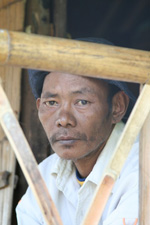



Tears welled in the Burmese woman’s eyes.
“I feel useless, depressed, desperate,” she told me. “I want to breathe the air of Burma, to taste Burmese food, to be with my friends. I want to be home.”
Khin Mar Htwe, 33, was a doctor in Rangoon treating AIDs patients when she joined the monks’ ‘saffron revolution’ marches against the junta last September.
Now she’s one of tens of thousands of Burmese exiles and refugees in Thailand, stranded in limbo without a country.
“I thought ‘they won’t arrest me because they can’t arrest everyone,’” she said of the Burmese authorities. “I was wrong. They came looking for me to put me in prison.”
She and her husband went into hiding to make a decision. Their choices: years in prison in Burma or the shackles of despair and uncertainty in Thailand. They chose the shackles.
“We had to leave,” she told me. “I don’t want to feel remorse now.”
I met her and her husband at a safe house in Mae Sot run by the National League for Democracy, the Burmese opposition party of Aung San Suu Kyi.
Others with similar stories came and went, all without jobs and most without hope. For three months, they were to get money from a supportive charity. After that, they were on their own.

Manshar had told me how small units of the KNU were fighting what he called the Burmese army’s genocide against the Karen people in eastern Burma. Still, he hoped for a peaceful change of government back home.
The killing of Manshar, with no arrests in the case, sent a chill through the ranks of antigovernment activists in Mae Sot. Who might be next?
Manshar had arranged for me to visit the biggest of the refugee camps, at Mae La, where some 45,000 mostly Karen refugees live on handouts from increasingly hard-pressed aid organizations. Some have been here as many as 20 years.
“People in this camp live in fear,” said Dr. Simon Saw, principal of the camp’s Kawthoolai Karen Baptist Bible School and College. “Curfew at 6 p.m., lights out at 9.”
Although Thai troops patrol the camp, Saw told me, they would not defend it if there was an attack from the Burmese army or its proxies.
As a result, he said, more and more refugees are applying to be resettled elsewhere—Australia, the United States, Canada, Europe—as their fear and frustration overwhelm hopes of returning to a democratic Burma.
The United Nations said that as of last September, it had helped 10,000 resettle. Refugees said the lucky ones are often given only hours to pack up and get on the bus to Bangkok for their flights to a new home.
Some succeed in their new lives. Others aren’t so fortunate.
Dr. Saw tells the story of a Burmese teacher who went to the United States and found the language and cultural barriers so high that the best job he could get was as a baby sitter. He returned to Mae La.
On the bus back to Bangkok, I sat next to a Burmese man who had been resettled from Mae La to Australia four years ago. Now he is working three jobs and going to college in Canberra. His two sons are growing up Australian.
I asked him if he and his family would return to Burma if the junta was overthrown.
“In a minute,” he said.
He’s not alone.
Tyler Chapman is a pseudonym to protect the author's sources.